Tesla's stock price continues to rise, proving the prospects of electric vehicles/hybrid vehicles and the market's need for greener/energy-saving travel methods. In order to reduce system power consumption, both traditional fuel vehicles and electric vehicles are trying to directly add a 48V DC bus system to the power system.
What are the benefits of using 48V? According to Ohm's law, the higher the voltage, the smaller the current, the smaller the loss and heat dissipation of the wire, which is why the power grid uses high-voltage transmission and distribution. For automobiles, the current 12.6V lead-acid battery is a long-standing compromise that takes into account factors such as size, capacity, cost, life and safety.
However, today's cars need to have more electronic equipment than cars a few years ago. In addition to basic functions such as engines, lights, radios, electric sunroofs, electric power steering, networks and infotainment, many other safety and convenience functions are now integrated, especially high-power ADAS systems. If 12V power supply is continued to be used, it will cause heating and loss of the wiring harness. If thicker wiring harnesses are used, it will not meet the lightweight and cost requirements of the car.
The birth of 48V power supply system
Unlike traditional 12V lead-acid batteries, the 48V battery uses a lithium battery system with higher weight and volume energy density.

In some ways, the 12V/48V mild hybrid system is a compromise solution, but unlike other compromise solutions, this solution has many advantages, reducing costs and improving efficiency and return rate (Source: Delphi Technology)
In this approach, a 48V battery - as specified in automotive standard LV148 - is used in conjunction with a 12V lead-acid battery (which is rated to provide 3KW of power) as a supplement. The 12V and 48V batteries will be used together with their distribution harnesses, with both batteries providing energy output when power output is needed. For example, the 12V bus can provide power for the ignition, lighting and infotainment systems, while the 48V bus will be responsible for chassis control systems, air conditioning, adjusting the suspension, recovering braking energy, driving electric superchargers and turbines, etc.
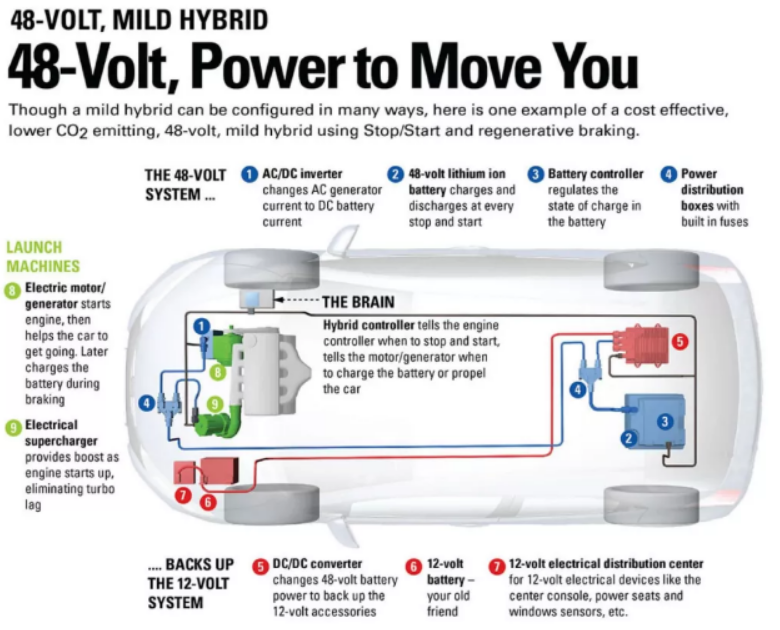
A dual voltage mild hybrid approach will effectively distribute the voltage and available power, which makes the most sense from an efficiency and operation perspective (Source: Delphi Technologies)
Consider a basic component: the starter. How does a 48V battery change the basic architecture of the engine starter, thereby better enhancing the start-stop effect, which is conducive to reducing fuel consumption when waiting at traffic lights and parking, and further enhancing fuel efficiency. In most cars with only 12V batteries, the battery provides power for the starter and the alternator serves as a charger. However, the combination of 48V and 12V can provide up to 10KW of power. The starter motor and independent alternator are replaced by an integrated starter generator (ISG) or a belt starter generator. The 48V lithium-ion battery and bidirectional DC/DC converter will be enclosed in a rugged box. This is actually a mild hybrid system that works in conjunction with the internal combustion engine. It can provide two-thirds of the benefits, but only one-third of the cost, and the economic benefits are increased by 15% to 20%.
Why 48V and 12V
More than 10 years ago, the industry's discussion on 24V was very intense, and some major manufacturers have even begun to produce 24V connectors, switches, relays and other basic components. In addition, the debate on whether cars should completely eliminate 12V batteries and only use 24V batteries, or let them coexist, has not been resolved. However, 24V voltage cannot better reflect the advantages brought by high bus voltage.
At the same time, in most areas, DC voltages exceeding 60V are considered unsafe and require special wiring precautions, safety locks, the use of conduits and physical shielding, etc. Therefore, 48V has become the mainstream standard, and the peak value of the 48V system will be lower than 60V, which means that safety requirements are met, thereby reducing steps such as safety certification.
The power management challenge
In addition to 48V, electric vehicles also have 800V/400V power battery systems. These high-voltage systems bring more challenges to power electronics design.
“Today’s challenges with electrification are: reducing costs, reducing CO2 emissions and the changing demands of power management, powering traditional 12V loads, increasing power levels for lighter, higher performance vehicles, accelerating charging times, and managing 800V and 400V battery systems,” said Patrick Wadden, global vice president of automotive business development at Vicor.
Manufacturers of cars, trucks, buses and motorcycles are trying to adopt more power electronics to improve the fuel efficiency of internal combustion engines and reduce carbon dioxide emissions. There are many electrification options, but most manufacturers choose 48-volt mild hybrid systems instead of full hybrid systems. In a mild hybrid system, a 48V battery is added in addition to the traditional 12V battery.
“When there is an 800V or 400V battery in the car, Vicor can directly convert 800V or 400V to 48V to power loads such as electric turbines, windshields and cooling pumps. By creating a 48V power bus, the 48V lithium battery power system can be completely eliminated, providing OEMs with higher power density while reducing weight and size, and these solutions are fully scalable to support a variety of needs from entry-level to luxury levels.
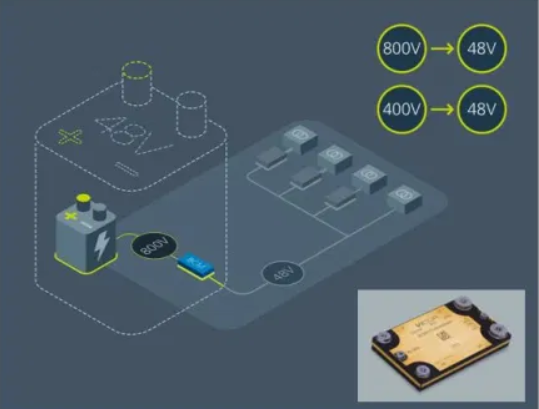
Figure: Enabling a virtual 48V battery (Source: Vicor)

Figure: System switching from 12V to 48V (Source: Vicor)
48V technology distributes power efficiently
48V technology can increase power capacity by 4 times (P=V*I), which can be used for heavier loads such as air conditioning and catalytic converters at startup. To improve vehicle performance, 48V systems can power hybrid vehicles, achieving faster and smoother acceleration while saving fuel.
“The biggest challenge is people’s hesitancy in the face of new technology,” said Wadden. “For the automotive industry, 48V mild hybrid systems offer a way to quickly introduce new vehicles with low emissions, long range, good fuel consumption and practicality. It also provides new and exciting design options for higher performance and functionality while also reducing CO2 emissions.”
Most centralized DC-DC converters are large and heavy because they use the old PWM low-frequency switching topology, so there is little demand in the industry to replace them. A more advanced architecture uses power modules and distributed power rails.
“The benefits of using a decentralized model can be realized at the system level, with lighter cables around the vehicle,” Wadden said. “There are benefits to placing the converter closest to the load, which minimizes impedance and resistance, simplifies cooling methods, and in some cases even eliminates cold plates or liquid cooling. This allows for more options and flexibility in achieving functional safety.”
This power delivery architecture uses smaller, lower-power 48V-12V converters, so the distributed power structure provides significant thermal management advantages in the power system.
“Let’s look at a diagram of a centralized system versus a decentralized system. On the left is a centralized traditional architecture with a 3.3KW onboard charger with a 400V input to a 12V output to power the 12V loads in the car. On the right is a distributed power architecture: the converter is placed at the load point, and the distributed architecture eliminates the onboard charger and distributes power around the vehicle as needed. This also allows for the use of redundant power supplies to achieve ASIL FUSA. As power demand increases, it becomes increasingly difficult to manage, and these older onboard chargers need to be eliminated,” Wadden said.
The new 48V PDN supports traditional 12V loads and can support new high-power drive, steering and braking systems using traditional wiring harnesses. High-density modules have advantages over larger, bulkier discrete solutions as loads continue to increase. Vicor offers a variety of modules for 48V power delivery, these devices include fixed ratio and adjustable conversion solutions, supporting 48V and 12V loads in buck or boost mode. These converters can be housed in a single housing or distributed throughout the vehicle using smaller and lighter 48V PDNs.
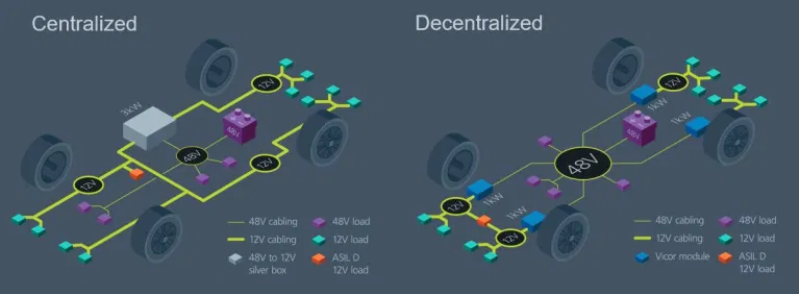
Figure: The difference between centralized and distributed architecture (Source: Vicor)
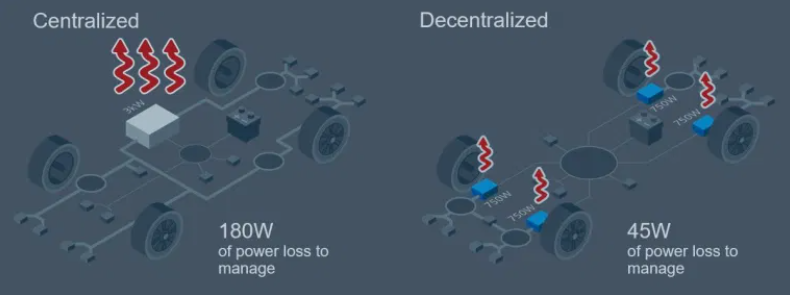
Figure: Comparison of power consumption loss between traditional mode and distributed mode. In comparison, the power consumption loss of centralized mode is four times that of distributed mode (Source: Vicor)
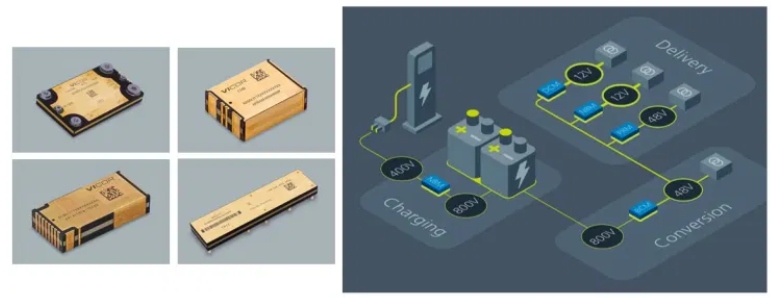
Figure: Vicor solution (Source: Vicor)
Vicor’s NBM family of products are the choice for OEMs when they need to place voltage converters around the vehicle closest to the load, either stepping down 48V to 12V or stepping up 12V to 48V.
When using 400V and 800V charging stations, the compatibility of the vehicle with any charging station requires the conversion solution to be as simple as possible, but most importantly efficient. The NBM6123 provides 6.4kW fixed ratio 400V and 800V conversion in a 61 x 23mm CM-Chip package, enabling a scalable, efficient, high-density solution for compatibility between roadside charging stations and different vehicles. The bidirectional capability of the Vicor solution allows the same module to be used for step-up or step-down conversion. The NBM6123 can also be used to deliver air conditioning to the vehicle during charging, minimizing battery balancing circuits.
in conclusion
Today, the electrification of vehicles is evolving in many forms and the power delivery systems are very complex. A vehicle has many different systems, each of which may have different power requirements. A modular power approach is inherently more flexible and scalable to meet a variety of challenges. Vicor's high-performance solutions are small and lightweight, designed to solve power conversion, charging and delivery problems in any system.
Previous article:CATL launches C2C and "rare metal-free batteries"
Next article:Over 8 million vehicles are waiting for matching! The “ups and downs” of lithium batteries in Europe
- Popular Resources
- Popular amplifiers
- Car key in the left hand, liveness detection radar in the right hand, UWB is imperative for cars!
- After a decade of rapid development, domestic CIS has entered the market
- Aegis Dagger Battery + Thor EM-i Super Hybrid, Geely New Energy has thrown out two "king bombs"
- A brief discussion on functional safety - fault, error, and failure
- In the smart car 2.0 cycle, these core industry chains are facing major opportunities!
- The United States and Japan are developing new batteries. CATL faces challenges? How should China's new energy battery industry respond?
- Murata launches high-precision 6-axis inertial sensor for automobiles
- Ford patents pre-charge alarm to help save costs and respond to emergencies
- New real-time microcontroller system from Texas Instruments enables smarter processing in automotive and industrial applications
- LED chemical incompatibility test to see which chemicals LEDs can be used with
- Application of ARM9 hardware coprocessor on WinCE embedded motherboard
- What are the key points for selecting rotor flowmeter?
- LM317 high power charger circuit
- A brief analysis of Embest's application and development of embedded medical devices
- Single-phase RC protection circuit
- stm32 PVD programmable voltage monitor
- Introduction and measurement of edge trigger and level trigger of 51 single chip microcomputer
- Improved design of Linux system software shell protection technology
- What to do if the ABB robot protection device stops
- Allegro MicroSystems Introduces Advanced Magnetic and Inductive Position Sensing Solutions at Electronica 2024
- Car key in the left hand, liveness detection radar in the right hand, UWB is imperative for cars!
- After a decade of rapid development, domestic CIS has entered the market
- Aegis Dagger Battery + Thor EM-i Super Hybrid, Geely New Energy has thrown out two "king bombs"
- A brief discussion on functional safety - fault, error, and failure
- In the smart car 2.0 cycle, these core industry chains are facing major opportunities!
- The United States and Japan are developing new batteries. CATL faces challenges? How should China's new energy battery industry respond?
- Murata launches high-precision 6-axis inertial sensor for automobiles
- Ford patents pre-charge alarm to help save costs and respond to emergencies
- New real-time microcontroller system from Texas Instruments enables smarter processing in automotive and industrial applications
- [Solved] How is the opencv library of dsp generated in the official data of DM8148
- Radar system basic design
- 【TI recommended course】#What is I2C design tool? #
- What is the relationship between the microcontroller baud rate, crystal oscillator and main frequency?
- Bluetooth low energy dimmable smart lighting solution
- TMS320C6000 Basic Learning (4) - cmd file analysis
- A summary of the most downloaded electronic technical materials this week (2020.5.10~15)
- GaN Finishing Station 2
- A DCDC board, originally powered by a battery, does not work when it is powered by a switching power supply. Why?
- Lead-acid battery charging methods and conventional charging introduction

 CMM6004-SC-0G00
CMM6004-SC-0G00











 京公网安备 11010802033920号
京公网安备 11010802033920号